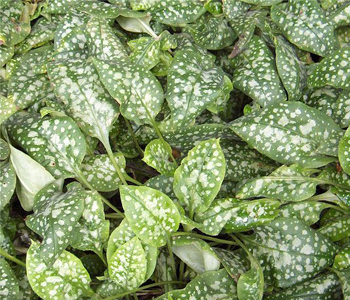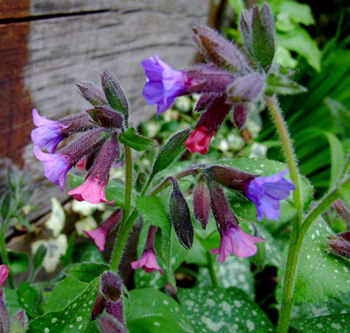Contents:
Common Names | Parts Usually Used | Plant(s) & Culture | Where Found | Medicinal Properties | Biochemical Information
Legends, Myths and Stories | Uses | Formulas or Dosages | Nutrient Content | Warning | Bibliography
Scientific Names

- Pulmonaria officinalis L.
- Boraginaceae
- Borage family
Common Names
- Jerusalem cowslip
- Jerusalem sage
- Lungmoss
- Maple lungwort
- Oak lungs
- Spotted comfrey
- Spotted lungwort
Parts Usually Used
Flowering herb
Back to Top

Description of Plant(s) and Culture
Lungwort is a perennial plant; the horizontal, creeping rootstock produces several bristly stems with alternate ovate, dark green leaves which are petioled at the bottom of the plant and become sessile near the top. The funnel-shaped flowers grow in terminal clusters from March to May. They turn from rose-colored to blue, both colors being found on the plant at the same time.
Other varieties: Bethlehem sage (P. saccarata) has white-spotted leaves and white to reddish violet flowers; the variety ‘Roy Davidson’ has gray-blue leaves with silvery splotches, flowers turn from clear blue to light pink; P. angustifolia has dark blue flowers; and P. montana has violet flowers and bright green leaves.
Back to Top
Where Found
Grows in shady areas, moist soil, cool to moderate temperatures; in Europe and in the northern parts of the United States; cultivated in gardens also.
Back to Top
Medicinal Properties
Antitussive, astringent, demulcent, emollient, expectorant, pectoral, mucilaginous, tonic
Back to Top
Biochemical Information
Mucilage, vitamins B and C, iron, copper, silver, manganese, kerotin, titan, nickel
Back to Top
Legends, Myths and Stories
In the Middle Ages it was commonly believed that the outward appearance of a plant was a God-given sign of the medicinal value contained within. Under this concept, called the Doctrine of Signatures, lungwort received its name: its lung-shaped leaves were considered a sign of its ability to treat lung diseases. Based on folklore, this doctrine was formally stated by the 16th century physician Philippus Aureolus Theophrastus Bombastus Paracelsus von Hohenheim. Interestingly, Native Americans had the same idea in their herb lore, even before they were exposed to white men. The problem with the concept is that, although it works well for some plants, it generally takes a great deal of creative imagination to match the outward appearance of most plants to the “appropriate” medicinal use.
Back to Top
Uses
Lungwort tea is used for diarrhea, hemorrhoids, respiratory problems, coughs, asthma, flu, colds, the grippe, catarrh, and hoarseness. It has mildly diuretic properties. The decoction may be helpful for bleeding lung problems. Externally, the plant is used for all kinds of wounds, ulcers, and sores. Decreases the menstrual flow when excessive.
Poultice helps enlarged thyroid, burns, tumors, and reduces swelling and inflammation from injuries and bruises.
Back to Top
Formulas or Dosages
Infusion: steep 1 tbsp. herb in 1 cup hot water. Take 1 cup per day.
Decoction: use the same quantities, but boil for a few minutes. Take 1 cup per day.
Juice: take 1 tsp., 3 times a day, with honey.
Powder: take 1 tsp., 3 times a day, with milk.
Back to Top
Nutrient Content
Vitamins B and C, iron
Back to Top
Warning
If a cough persists for more than 2 weeks, do not try to treat it. See a medical professional immediately.
Back to Top
Bibliography
![]() Back to Eden
Back to Eden, by Jethro Kloss; Back to Eden Publishing Co., Loma Linda, CA 92354, Original copyright 1939, revised edition 1994
![]() Culpeper’s Complete Herbal & English Physician: Updated With 117 Modern Herbs
Culpeper’s Complete Herbal & English Physician: Updated With 117 Modern Herbs, by Nicholas Culpeper, Meyerbooks, publisher, PO Box 427, Glenwood, Illinois 60425, 1990, (reprint of 1814)
 Earl Mindell’s Herb Bible
Earl Mindell’s Herb Bible, by Earl Mindell, R.Ph., Ph.D., Simon & Schuster/Fireside, Rockefeller Center 1230 Avenue of the Americas, New York, New York 10020
![]() The Herb Book
The Herb Book, by John Lust, Bantam Books, 666 Fifth Avenue, New York, NY. copyright 1974.
Herbal Gardening, compiled by The Robison York State Herb Garden, Cornell Plantations, Matthaei Botanical Gardens of the University of Michigan, University of California Botanical Garden, Berkeley., Pantheon Books, Knopf Publishing Group, New York, 1994, first edition
![]() Indian Herbalogy of North America
Indian Herbalogy of North America, by Alma R. Hutchens, Shambala Publications, Inc., Horticultural Hall, 300 Massachusetts Avenue, Boston, Massachusetts 02115, 1973
![]() Planetary Herbology
Planetary Herbology, by Michael Tierra, C.A., N.D., O.M.D., Lotus Press, PO Box 325, Twin Lakes. WI 53181., Copyright 1988, published 1992
![]() Webster’s New World Dictionary
Webster’s New World Dictionary, Third College Edition, Victoria Neufeldt, Editor in Chief, New World Dictionaries: A Division of Simon & Schuster, Inc., 15 Columbus Circle, New York, NY 10023
